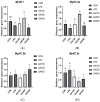Effects of Dietary Gallic Acid on Growth Performance, Meat Quality, Antioxidant Capacity, and Muscle Fiber Type-Related Gene Expression in Broiler Chickens Challenged with Lipopolysaccharide
- PMID: 39765574
- PMCID: PMC11727612
- DOI: 10.3390/ani14243670
Effects of Dietary Gallic Acid on Growth Performance, Meat Quality, Antioxidant Capacity, and Muscle Fiber Type-Related Gene Expression in Broiler Chickens Challenged with Lipopolysaccharide
Abstract
In this study, broilers were selected as the research object to investigate the effects and mechanisms of dietary gallic acid (GA) supplementation on growth performance, meat quality, antioxidant capacity, and muscle fiber-related gene expression. A total of 750 one-day-old healthy 817 male crossbred broiler chickens were divided into five treatment groups, with six replicates per group. Birds in the control (CON) group and LPS-challenged treatment (LPS) group were fed a basal diet, and birds in the other three treatment groups received the basal diet with 150, 300, or 450 mg/kg added GA (GA150, GA300, GA450). On days 14, 17, and 20, chickens in the LPS, GA150, GA300, and GA450 groups received intramuscular injections of LPS, while chickens in the CON group received saline. The results showed that the addition of GA to the diet could effectively increase the average daily gain (ADG) of broilers from 1 to 50 days of age, and had a trend (p = 0.078) of increasing the average daily feed intake (ADFI). Adding 450 mg/kg GA to the diet significantly reduced (p < 0.05) the drip loss and pH value of pectoral muscles 45 min after slaughter, and significantly increased (p < 0.05) the lightness value of pectoral muscles 45 min post-slaughter. With an increase in GA level, the content of total volatile basic nitrogen (TVB-N) in pectoral muscles decreased linearly (p < 0.05), and the concentration of C22:6n-3 increased linearly (p < 0.05). GA effectively improved (p < 0.05) the antioxidant capacity of muscles and significantly increased (p < 0.05) the activity of total superoxide dismutase (T-SOD) in pectoral muscles after LPS stimulation, exhibiting linear and quadratic changes (p < 0.05). It also significantly increased (p < 0.05) the activity of hydrogen peroxide and decreased the activity of glutathione peroxidase (GSH-Px), while it linearly decreased (p < 0.05) the content of malondialdehyde (MDA). In addition, the dietary supplementation of GA significantly increased (p < 0.05) the expression levels of myosin heavy chain (MyHC) I and MyHC IIa in pectoral muscles and significantly decreased (p < 0.05) the expression level of MyHC IIx. In summary, the dietary addition of GA can alleviate the effect of the stress response on the growth performance of broiler chickens and improve antioxidant capacity and meat quality. The appropriate amount of dietary GA at each stage was 300 mg/kg.
Keywords: antioxidant capacity; broiler; gallic acid; growth performance; lipopolysaccharide; meat quality.
Conflict of interest statement
The authors declare no conflicts of interest.
Figures

References
Grants and funding
- (CARS-41-G06)/China Agriculture Research System of MOF and MARA
- 2021YFD1300404/the National Key R&D Project
- 2023A0505050104/the Science and Technology Planning Project of Guangdong Province
- 2020B0202090004/the Key Realm R&D Program of Guangdong Province
- 2021A1515012412, 2021A1515010830, 2022A1515012069/the Natural Science Foundation from Guangdong Province
LinkOut - more resources
Full Text Sources

